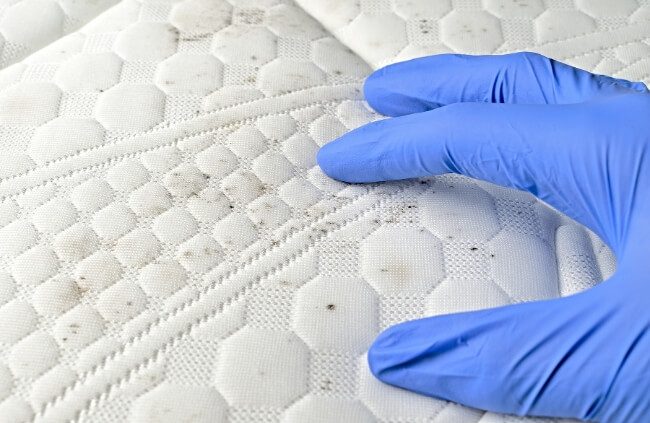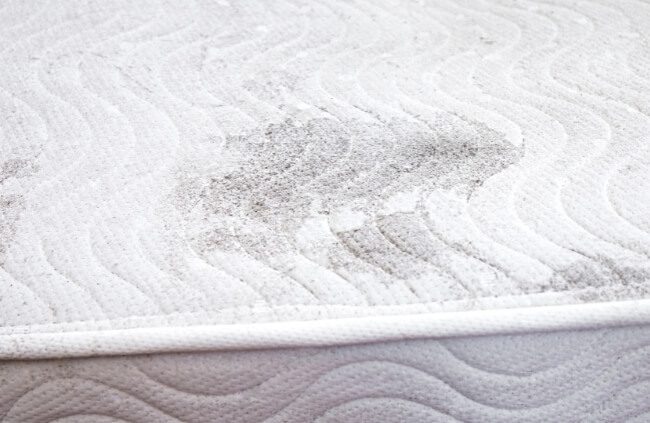Unlike more common mattress stains and spills, mould on mattress can pose a serious health risk in bedrooms if left unchecked. Naturally, many homeowners are shocked to discover these sprawling dark stains when they lift their sheets but mattress mould is actually quite common.
Knowing what causes mattress mould, how to identify and prevent it, and knowing how to treat it will go a long way in keeping your sleeping environment as healthy and comfortable as possible!
In today’s comprehensive guide, we will be sharing our top tips for how to get rid of mould on your mattress while giving you everything you need to know about mould growth in bedrooms so you can create the safest space for you and your family.
With over 10 years of experience in Australia, we’ve helped thousands of customers deal with mould on their mattress so we’ve certainly got you covered in this guide!
What Causes Mould on a Mattress?

Mould spores are a common and natural component of our ecosystem and air but should not be allowed to grow in excess on mattresses. Mattress mould is a product of bacteria and moisture that combines over time on our mattresses, often leading to severe staining and dampness if left untreated.
Regularly cleaning your mattress will allow you to pick up any early signs of mould growth, giving you the best chance to eliminate it promptly.
A mouldy mattress is almost always caused by environmental factors. Warm, humid, and poorly ventilated areas are most at risk, much like our bedrooms, bathrooms and kitchens here in Australia.
Let’s take a look at some of the most common causes of mould growth on mattresses.
An Overly Wet and Humid Room
Excess moisture and humidity in bedrooms will allow mould to thrive. This can include poorly ventilated rooms but also human factors like sweat and liquid stains that are left to sit. Unfortunately, mould can form in only 24 to 48 hours, so treating spills, accidents, or any other kind of moisture immediately is essential.
Keeping Your Mattress on the Ground
Sufficient airflow on all surfaces of your mattress will massively help to deter mould spores from growing. A mattress that is kept on the ground for extended periods without being rotated and flipped could quickly start to develop mould. We recommend flipping your mattress monthly.
Insufficient Airflow
As we’ve mentioned, airflow is an essential component of maintaining a healthy mattress. Bedrooms without proper ventilation are usually at high risk of mould from a mattress. Poor air quality can also affect how mould grows in bedrooms.
Poor Bedroom Hygiene
Mould spores are encouraged by surrounding organic materials like dead skin, bacteria, and even food crumbs and drink splotches. A clean and sterile bedroom environment will play a big role in the production of mould on a mattress.
Your Bedroom May be Too Warm
Mould spores thrive in temperatures of between 21ºC and 30ºC. Unfortunately, that suits many of our local climates and regions throughout Australia. Try to maintain a room temperature of around 20ºC or less by opening windows when needed.
Preventing Mould on a Mattress
As the old proverb goes, prevention is better than a cure, and this sticks true with our mattress maintenance as well. Luckily, there are a few things you can do to prevent future mould growth on your mattress. Here are some of our top tips.

Clean Your Mattress Regularly
Let’s start with the most obvious preventive measure you can take – to regularly clean your mattress and bedding. We recommend getting your mattress cleaned at least twice a year.
Check out our guide if you’re not sure how to clean a mattress at home for everything you need to know!
Avoid Drying Clothes in Your Bedroom
If you dry your damp clothes and towels on radiators or clothes racks in your bedroom, you could be promoting too much moisture and humidity, leading to mould growth. Try to use other areas of the house to avoid mould on a mattress.
Avoid Eating and Drinking in Bed
By eating and drinking in bed, you are naturally increasing the risk of spills and stains on the bed. Even small food crumbs that have fallen onto your mattress will help to feed mould bacteria so try to create the best bedroom hygiene you possibly can at all times.
Air Out Your Bedroom Regularly
If you can, try to air your bedroom daily once you’re up and about. This can include opening windows or a sliding door, or even just leaving your air conditioner or fan on, even while you’re out for short spurts.
When airing out, pull your covers and sheets back for a few hours in the morning before making the bed for the day.
Flip and Rotate Your Mattress
Mould thrives in moist and dark environments, so by regularly flipping and rotating your mattress, you will ensure all surfaces get the chance to breathe and get some light, which in turn will help to deter mould. This will also ensure ventilation to the mattress bottom at all times.
Use a Dehumidifier or Air Purifier if Needed
An air purifier or dehumidifier can be a useful tool for combating mould. Air purifiers will help to filter and circulate the air in your bedroom, leading to a higher indoor air quality. Dehumidifiers can be placed in your room near the mattress to help absorb as much surrounding air moisture as possible, helping to prevent mould.
Use a Mattress Protector
Mattress protectors are valuable additions to preserve and extend the life of your bed. There are even waterproof mattress protectors available that will massively help prevent any moisture from reaching your mattress in the first place.
Clean Spills Immediately
Should you spill anything on your mattress or an accident occurs, try to clean it up as soon as you can to prevent excess moisture from seeping deep into your mattress.
Health Risks of Mould on Your Mattress
Mould can have serious and varying health risks for people and pets alike. Seeing as we spend about 8 hours in bed every night, it’s easy to see why a clean and hygienic mattress is so important.
Here are some of the common health risks of mould on a mattress:
- Respiratory issues, especially while in bed
- Increased risk of migraines, fatigue and depression
- Itching eyes and more frequent coughing and sneezing
- Increased issues with congestion, itchy skin, and rashing
- More severe allergic reactions
Identifying Mould on a Mattress: Mildew vs Mould
Appearance
Mould spores often show early warning signs on mattresses. Usually, you will start to see tiny black spots on the sides and bottom of the mattress, followed by some sort of spreading habit. This is a type of common black mould fungus, known as mildew.
Mildew is relatively easy to treat, often just requiring a good wipe with a wet cloth. Regularly inspecting your mattress will ensure you pick up these developmental signs early for treatment.
If the mildew is left untreated, it will grow stronger and start to take over the entire mattress, posing significant health risks when the mould begins to release spores while damaging the mattress itself.
The mould will eventually become larger, fuzzier segments, which can be black or white in appearance. This type of mould growth will be harder to combat than its early mildew counterpart. Removing mould like this may require you to use professionals if it’s severe.
Smell
When mould spores are released, they are typically accompanied by lingering musty odours around the bed that may perhaps cover the entire bedroom. Many associate the smell with old wood or damp socks. Some nearby furniture may also begin to show signs of warping or discolouration.
Mould Can Affect Many Types of Mattresses
Unfortunately, mould can be stubborn and while a natural latex mattress or memory foam mattress may have mould-resistant properties, they are still susceptible to mould in favourable conditions.
Mould can still become an issue on almost any type of mattress – from latex mattresses to memory foam mattresses, and of course, sprung mattresses as well.
How to Get Rid of Mould on Mattress: Step-by-Step Guide

Remove All Bedding and Sheets
Start by removing all of your bedding including your sheets, duvet cover, pillowcases, and mattress protector if you have one. Give everything a good wash while you tackle the mattress itself.
Inspect the Damage
Check for all stains and possible signs of mould growth on your mattress so you can paint a mental picture of the treatment plan ahead.
Vacuum All Mattress Surfaces
Vacuum the accessible sides and top of the mattress thoroughly using the vacuum’s upholstery attachment or a similar high-pressure attachment. Once done, flip the mattress and vacuum again on the other side, eventually covering all surfaces.
Ensure to focus on the mouldy areas and fully empty your vacuum when done.
Spot Treat Stains and Mould Growth on Both Sides
Using a cleaning solution of your choice, spot-treat mould stains and mouldy areas with a damp cloth by wiping them in a circular motion. Treat all the mattress surfaces to prevent any spread in the future. Repeat treatment if needed.
Here are some options for a cleaning solution:
Use a Dedicated Mould Cleaner for Mattresses
Apply as per the manufacturer’s guidelines. Try to find a cleaner specifically designed for fabric surfaces. Be sure to also wear any necessary protective gear.
Use a Homemade Cleaning Solution
You can mix some warm water with dishwashing soap or a similar mild detergent and add a touch of lemon juice, vinegar, and some baking soda. Place this solution in a misting bottle to treat affected areas, then wipe down properly.
Use Rubbing Alcohol
Mix 60% to 90% rubbing alcohol with equal parts water. Dab the solution over the visible mould spots, then gently wipe with a cloth. A good alternative is 3% hydrogen peroxide mixed at a 3:1 ratio with some water as well.
Sprinkle Some Baking Soda
Once you’ve cleaned the mattress, you can sprinkle some baking soda or bicarb soda over the areas you cleaned to help absorb any lingering moisture and eliminate any odours.
Flip and Repeat!
If you haven’t already, flip the mattress to repeat the vacuuming and spot treatment steps above to ensure the entirety of the mattress has been deep cleaned.
Air Your Mattress Out
Once fully clean, move your mattress to a well-ventilated location and allow it to dry for as long as possible, flipping and rotating it as needed. Performing the cleaning in the morning will give you a full day for drying, which is ideal.
For the best results, move the mattress into the sun for a few hours! The sun’s UV rays can help to quickly kill microorganisms like mould. Once dry, you can place your mattress on its base and make the bed.
When to Hire Myer Carpet Cleaning
While mild cases of mould on a mattress can be treated at home, more severe cases may call for professionals with the experience, specialised equipment, and cleaning products needed to tackle more extreme staining and mould growth.
Here at Myer Carpet Cleaning, we specialise in premium carpet and mattress steam cleaning in Melbourne, Sydney, Perth, and Brisbane. With over 10 years of experience helping Australian homeowners, our team of professional technicians will have your mattress looking new again, without any hassle from your end!
Be sure to contact us today if you are experiencing:
- Extensive mould infestation on your mattress and surrounding environment
- If you have serious health concerns with mould growth in your bedroom
- If you have limited time or accessibility issues for cleaning your mattress
Mould on Mattress: Wrapping Up Our Guide
So, there you have it, our top tips for how to get rid of mould on a mattress!
It’s easy to see why mould on a mattress needs to be treated right away, and with this guide, we hope you also have an effective strategy for preventing any mould issues in the first place.
Be sure to contact Myer Carpet Cleaning today for all your steam cleaning needs across Australia!
